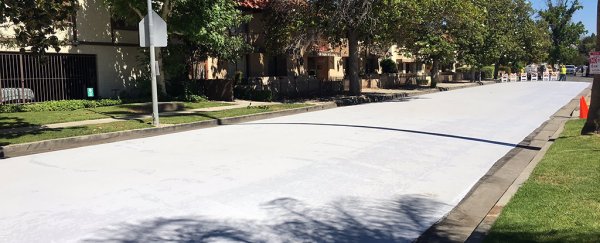There are many ways we can combat temperatures rising on our planet. The city of LA has hit upon one small change that could make a big difference: painting its streets grey.
This isn't any ordinary grey paint though. It's a special coating called CoolSeal that was originally developed to hide the heat created by airstrips, making them less visible to spy satellites overhead.
Here, though, the rather clever idea is that CoolSeal is better at reflecting solar rays, and the paint has already been tested on an LA parking lot in one of the hottest parts of the city, proving its potential for reducing the temperatures at ground level.
"We found that on average the area covered in CoolSeal is 10 degrees [F (5 degrees C)] cooler than black asphalt on the same parking lot," city official Greg Spotts told Peter Holley at The Washington Post.
"We thought it was really interesting. It's almost like treated asphalt warms at a lower rate."
The smart painting program is intended to tackle what's known as the urban heat island effect, where pockets of urban development – with concrete, asphalt, dark roofs, and a lack of shade from vegetation – send temperatures soaring.
Once a city hits more than a million people its temperatures can go up to 12°C (22°F) higher than the level of the surrounding areas thanks to the effect.
That in turn means an increased danger of heat exhaustion in the hottest cities and, of course, more people switching on their air conditioning units and using up energy.
According to city officials the coating should reduce temperatures, help those working outside, and even make the ground surface more pleasant for pets. The areas already treated will be monitored during the autumn, ready for a wider roll-out in the future.
As an added bonus, because the coating is extra-reflective, less energy is required to light up the roads and parking lots covered in CoolSeal too.
And it's not the only innovative way scientists are coming up with ways of cooling off urban areas. Studies have shown that increasing foliage in a city and covering buildings with plant life can also reduce temperatures, as well as soaking up carbon dioxide.
Between cooling down the atmosphere we have and making sure we limit how much hotter it gets, there's still hope for easing some of the effects of climate change in our urban environments.
Every little bit helps – even if it's just changing the colour of the parking lot outside.
LA is the first city to try cooling its streets and it's part of a bigger commitment to reduce overall temperatures in the city by 3°F (around 1-2°C) over the next 20 years.
"We think that more than 10 percent of the city is asphalt – that's 69,000 city blocks," Spotts told The Post. "There's been estimates that suggest covering a third in the city's pavement with a cooler materials might be able to move the needle on the city's temperature."
"We're not ready to do that, but we do want to explore what it might take to go big and take this thing to scale."
